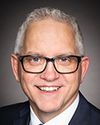Thank you.
[Witness speaks in Cree]
[English]
Thank you, Chair.
I want to first acknowledge that I'm in Treaty 7 territory here in Calgary.
I want to thank the chair and committee members for the opportunity to speak today.
My name is Stephen Buffalo. I'm the president and CEO of the Indian Resource Council of Canada. Our organization represents over 130 first nations that have produced or have direct interests in the oil and gas industry. Our mandate is to advocate for federal policies that will improve and increase resource development opportunities for first nations.
Although our main focus is oil and gas, many of our members are engaged in solar, wind projects, transmission lines and carbon capture and are starting to look at equity opportunities in nuclear reactors and SMRs.
I'm sure members of the committee know that first nations have historically been excluded from economic opportunities in this country. We have had little say about the activities taking place on our lands even as they have diminished our aboriginal and treaty rights.
We want to resuscitate our economies, and land, of course, is quid pro quo for economic development. Our reserve population is growing, the fastest-growing population in Canada, but our lands are not growing. In fact, they are shrinking, especially our traditional lands, so this committee hearing is very important and very timely.
I know other presenters have spoken about the legal basis for land restitution to our communities, along with our treaties and most recently UNDRIP and the recommendations from the Truth and Reconciliation Commission. We have made our case for land restitution time and time again, and Canadian law is on our side.
The problem is that the enforcement system is broken. Best efforts relating to the additions to reserve, the ATR policy, and the treaty land entitlement in the modern treaties, especially in B.C., are well intended, but the process is lengthy and very expensive.
For me, land restitution is a continuum. It should not be one size fits all. We have our reserve lands, which are shrinking by the day, and the increase in demand for housing infrastructure and development. There are many outstanding cases to add reserve lands and/or compensation based on what was agreed to in the treaties. This process must be concluded in a timely manner.
We also need to protect what little we have left, so land stewardship is very important to us. This is why we were very proactive in the site reclamation and site rehabilitation program and were able to secure a portion of the $1-billion federal grant specifically for abandoned and depleted wells on our land. To date, first nations have cleaned over 2,000 wells, and there are many more to go, especially with orphaned wells that do not have any owners.
Critics claim that the responsibility belongs to the owners, based on the “polluter pays” principle, but this is a ticking bomb. We can't wait for the polluters to do the right thing. Our people need their land restored as soon as possible.
In my community of Maskwacis we have old pipelines criss-crossing our lands, and we cannot build houses in these areas, so pipelines must be removed. Our elders have told us this much. We need the resources to finish this work.
We had a fiduciary trustee by the name of Indian Oil and Gas Canada, which is a special operating agency under Indigenous Services Canada. They were supposed to protect our reserve lands. Unfortunately they failed miserably in this regard. They were nowhere to be seen when we lobbied hard for the site rehabilitation program. They did not even have the data on these wells. We had to invest some money to get our own, working closely with data providers such as AssetBook and geoSCOUT. Now we know where the wells are and which ones need to be addressed.
Further, Indian Oil and Gas has failed to hold lessees accountable for their liabilities. It seems it protects industry more than it protects first nations, so currently we are working hard to transform Indian Oil and Gas Canada into a first nations-led regulator.
There are many initiatives currently in place in which indigenous people have partnerships, equity participation and industry on these lands, which we applaud, but a lot more work needs to be done.
I want to mention and commend the Government of Alberta for the Indigenous Opportunities Corporation, through which first nations have participation in projects in their traditional area.
I want to end by mentioning that our issue with resource revenue sharing is unfinished business. Our organization is lobbying hard to put this matter on the table. For me, resource revenue sharing and land restitution go hand in hand.
Thank you. I'd be happy to answer any questions.




